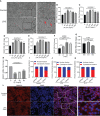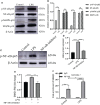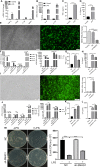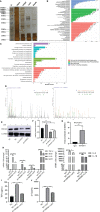Tanreqing Injection Attenuates Macrophage Activation and the Inflammatory Response via the lncRNA-SNHG1/HMGB1 Axis in Lipopolysaccharide-Induced Acute Lung Injury
- PMID: 35547731
- PMCID: PMC9084914
- DOI: 10.3389/fimmu.2022.820718
Tanreqing Injection Attenuates Macrophage Activation and the Inflammatory Response via the lncRNA-SNHG1/HMGB1 Axis in Lipopolysaccharide-Induced Acute Lung Injury
Abstract
The etiology of acute lung injury (ALI) is not clear, and the treatment of ALI presents a great challenge. This study aimed to investigate the pathogenesis and potential therapeutic targets of ALI and to define the target gene of Tanreqing (TRQ), which is a traditional Chinese medicine formula composed of five medicines, scutellaria baicalensis, bear bile powder, goat horn powder, honeysuckle and forsythia. Macrophage activation plays a critical role in many pathophysiological processes, such as inflammation. Although the regulation of macrophage activation has been extensively investigated, there is little knowledge of the role of long noncoding RNAs (lncRNAs) in this process. In this study, we found that lncRNA-SNHG1 expression is distinctly regulated in differently activated macrophages in that it is upregulated in LPS. LncRNA-SNHG1 knockdown attenuates LPS-induced M1 macrophage activation. The SNHG1 promoter was bound by NF-κB subunit p65, indicative of SNHG1 being a direct transcriptional target of LPS-induced NF-κB activation. SNHG1 acts as a proinflammatory driver that leads to the production of inflammatory cytokines and the activation of macrophages and cytokine storms by physically interacting with high-mobility group box 1 (HMGB1) in ALI. TRQ inhibited NF-κB signaling activation and binding of NF-κB to the SNHG1 promoter. In conclusion, this study defined TRQ target genes, which can be further elucidated as mechanism(s) of TRQ action, and provides insight into the molecular pathogenesis of ALI. The lncRNA-SNHG1/HMGB1 axis is an ideal therapeutic for ALI treatment.
Keywords: NF-κB signaling pathway; acute lung injury/acute respiratory distress syndrome (ALI/ARDS); high mobility group protein 1 (HMGB1); long noncoding RNA (lncRNA); macrophage polarization; tanreqing injection.
Copyright © 2022 Hu, Li, Tan, Liu, Bai, Gao, Zhao, Yao, Lu, Qiu and Xing.
Conflict of interest statement
The authors declare that the research was conducted in the absence of any commercial or financial relationships that could be construed as a potential conflict of interest.
Figures









Similar articles
-
Psoralen alleviates acute lung injury by covalently targeting Cys106 of HMGB1 in macrophages to inhibit inflammatory responses.Phytomedicine. 2025 Jul;142:156807. doi: 10.1016/j.phymed.2025.156807. Epub 2025 Apr 26. Phytomedicine. 2025. PMID: 40311596
-
Paeonol attenuates acute lung injury by inhibiting HMGB1 in lipopolysaccharide-induced shock rats.Int Immunopharmacol. 2018 Aug;61:169-177. doi: 10.1016/j.intimp.2018.05.032. Epub 2018 Jun 5. Int Immunopharmacol. 2018. PMID: 29883962
-
LncRNA SNHG1 knockdown attenuates lipopolysaccharide-induced acute lung injury via regulating miR199a-3p/ROCK2 axis.Gen Physiol Biophys. 2024 Sep;43(5):399-409. doi: 10.4149/gpb_2024015. Gen Physiol Biophys. 2024. PMID: 39140680
-
Macrophage polarization and its role in the pathogenesis of acute lung injury/acute respiratory distress syndrome.Inflamm Res. 2020 Sep;69(9):883-895. doi: 10.1007/s00011-020-01378-2. Epub 2020 Jul 10. Inflamm Res. 2020. PMID: 32647933 Free PMC article. Review.
-
High-mobility group box 1 (HMGB1) in COVID-19: extrapolation of dangerous liaisons.Inflammopharmacology. 2022 Jun;30(3):811-820. doi: 10.1007/s10787-022-00988-y. Epub 2022 Apr 26. Inflammopharmacology. 2022. PMID: 35471628 Free PMC article. Review.
Cited by
-
Therapeutic potential of traditional Chinese medicine on heat stroke.Front Pharmacol. 2023 Sep 25;14:1228943. doi: 10.3389/fphar.2023.1228943. eCollection 2023. Front Pharmacol. 2023. PMID: 37818183 Free PMC article. Review.
-
Effects of Tanreqing injection against ventilator-associated pneumonia: a meta-analysis and systematic review of clinical studies.Front Pharmacol. 2025 Mar 7;16:1545088. doi: 10.3389/fphar.2025.1545088. eCollection 2025. Front Pharmacol. 2025. PMID: 40124787 Free PMC article.
-
Tetramethylpyrazine mitigates lipopolysaccharide-induced acute lung injury by inhibiting the HMGB1/TLR4/NF-κB signaling pathway in mice.J Thorac Dis. 2025 Mar 31;17(3):1605-1616. doi: 10.21037/jtd-24-1561. Epub 2025 Mar 26. J Thorac Dis. 2025. PMID: 40223972 Free PMC article.
-
Insight into the lncRNA-mRNA Co-Expression Profile and ceRNA Network in Lipopolysaccharide-Induced Acute Lung Injury.Curr Issues Mol Biol. 2023 Jul 24;45(7):6170-6189. doi: 10.3390/cimb45070389. Curr Issues Mol Biol. 2023. PMID: 37504305 Free PMC article.
-
Integrated Analysis of Non-Coding RNA and mRNA Expression Profiles in Exosomes from Lung Tissue with Sepsis-Induced Acute Lung Injury.J Inflamm Res. 2023 Sep 1;16:3879-3895. doi: 10.2147/JIR.S419491. eCollection 2023. J Inflamm Res. 2023. PMID: 37674532 Free PMC article.
References
-
- Lin S, Shi Q, Ge Z, Liu Y, Cao Y, Yang Y, et al. . Efficacy and Safety of Traditional Chinese Medicine Injections for Heart Failure With Reduced Ejection Fraction: A Bayesian Network Meta-Analysis of Randomized Controlled Trials. Front Pharmacol (2021) 12:659707. doi: 10.3389/fphar.2021.659707 - DOI - PMC - PubMed
MeSH terms
Substances
LinkOut - more resources
Full Text Sources
Research Materials

